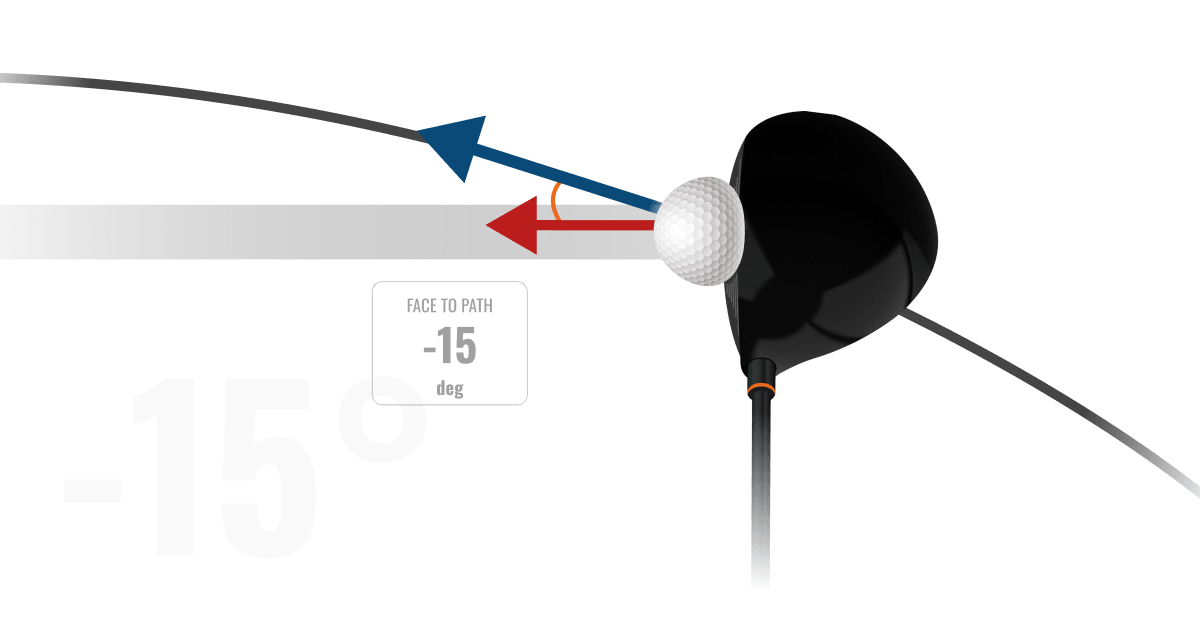What is Face to Path?


The difference between the face angle and the club path, Face to Path is a key factor in determining the expected curvature (spin axis) of a golf shot.
Face to Path is important in determining the expected curvature (spin axis) of a golf shot. Assuming centered contact, the ball should curve towards the face angle and away from the club path (if Face to Path is not equal to zero).
For a right-handed golfer, a negative Face to Path would represent a face angle that is ‘closed’ to the path and a positive Face to Path would represent a face angle that is ‘open’ to the path.
A zero Face to Path represents a face angle and club path that have the same value.
Note that Face to Path is relative to the face angle and club path. It is not relative to the target line. A Face to Path of zero could be +5, 0, -5, or any other value relative to the target line. The zero Face to Path only represents the difference between where the club is moving horizontally (club path) and where the club face is pointed horizontally (face angle).
To learn more, check out this video showing Martin Chuck of Revolution Golf explaining Face to Path.
Technical Definition:
Face to Path – The angle difference between FACE ANGLE and CLUB PATH as defined (FACE ANGLE minus CLUB PATH).
A positive Face to Path means the face is pointed to the right of the club path regardless of dexterity.
A negative Face to Path means the face is pointed to the left of the club path regardless of dexterity.
Face to path examples (assuming centered contact)
PGA TOUR Driver (275 yard carry)
-2 degree Face to Path ≈ 19 yards of left curvature
5 degree Face to Path ≈ 44 yards of right curvature
PGA TOUR 6-iron (183 yard carry)
2 degree Face to Path ≈ 8 yards of right curvature
-5 degree Face to Path ≈ 20 yards of left curvature
LPGA Tour Driver (218 yard carry)
2 degree Face to Path ≈ 14 yards of right curvature
-5 degree Face to Path ≈ 32 yards of left curvature
LPGA Tour 6-iron (152 yard carry)
-2 degree Face to Path ≈ 6 yards of left curvature
5 degree Face to Path ≈ 14 yards of right curvature
The standard assumption for Face to Path is zero for all clubs. It is a standard assumption that the ball starts straight at the target and has no curvature (zero spin axis).
Read what our Trackman University Masters say about Face to Path…
“For elite players who consistently drive the ball 300 yards plus, a maximum of 1 degree Face to Path difference is essential for consistent, accurate drives, given that a typical PGA TOUR fairway is only 30-32 yards wide. One degree Face to Path difference at 300 yards will produce a shot with 12 yards of curve. Any more than 1.5 degree Face to Path will force the player to aim away from the fairway in order to hit the center of the fairway.”

John Parkinson
Donau Golf Club, Germany
“Face to Path is a great number to look at because it combines two key parts of the swing at impact that can influence launch direction and spin axis. I always like looking at Face to Path to explain contact on the club face to a customer. One could see a negative Face to Path but a positive spin axis. Being able to show and explain the reason behind this is extremely helpful.”

Ryan Johnson
Carl’s Golfland, MI, US
“Firstly, I’m looking for the Face to Path relationship to be both consistent and matching the player’s desired shot shape. I use this in conjunction with spin axis to check for centered contact and determine where the player tends to miss their strike.”

Hugh Marr
Premium Golf Consulting, UK